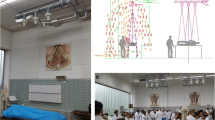Abstract
Goal, Scope and Background
Cadavers for gross anatomy laboratories are usually prepared by using embalming fluid which contains formaldehyde (FA) as a principal component. During the process of dissection, FA vapors are emitted from the cadavers, resulting in the exposure of medical students and their instructors to elevated levels of FA in the laboratory. The American Conference of Governmental Industrial Hygienists (ACGIH) has set a ceiling limit for FA at 0.3 ppm. In Japan, the Ministry of Health, Labour and Welfare has set an air quality guideline defining two limit values for environmental exposure to FA: 0.08 ppm as an average for general workplaces and 0.25 ppm for specific workplaces such as an FA factory. Although there are many reports on indoor FA concentrations in gross anatomy laboratories, only a few reports have described personal FA exposure levels. The purpose of the present study was to clarify personal exposure levels as well as indoor FA concentrations in our laboratory in order to investigate the relationship between them.
Methods
The gross anatomy laboratory was evaluated in the 4th, 10th and 18th sessions of 20 laboratory sessions in total over a period of 10 weeks. Air samples were collected using a diffusive sampling device for organic carbonyl compounds. Area samples were taken in the center and four corners of the laboratory during the entire time of each session (4-6 hours). Personal samples were collected from instructors and students using a sampling device pinned on each person's lapel, and they were 1.1 to 6 hours in duration. Analysis was carried out using high performance liquid chromatography.
Results and Discussion
Room averages of FA concentrations were 0.45, 0.38 and 0.68 ppm for the 4th, 10th and 18th sessions, respectively, ranging from 0.23 to 1.03 ppm. These levels were comparable to or relatively lower than the levels reported previously, but were still higher than the guideline limit for specific workplaces in Japan and the ACGIH ceiling limit. The indoor FA concentrations varied depending on the contents of laboratory sessions and seemed to increase when body cavity or deep structures were being dissected. In all sessions but the 4th, FA levels at the center of the room were higher than those in the corners. This might be related to the arrangement of air supply diffusers and return grills. However, it cannot be ruled out that FA levels in the corners were lowered by leakage of FA through the doors and windows. Average personal exposure levels were 0.80, 0.45 and 0.51 ppm for instructors and 1.02, 1.08 and 0.89 ppm for students for the 4th, 10th and 18th session, respectively. The exposure levels of students were significantly higher than the mean indoor FA concentrations in the 4th and 10th sessions, and the same tendency was also observed in the 18th session. The personal exposure level of instructors was also significantly higher than the indoor FA level in the 4th session, while they were almost the same in the 10th and 18th sessions. Differences in behavior during the sessions might reflect the differential personal exposure levels between students and instructors.
Conclusion
The present study revealed that, if a person is close to the cadavers during the gross anatomy laboratory, his/her personal exposure level is possibly 2 to 3-fold higher than the mean indoor FA concentration. This should be considered in the risk assessment of FA in gross anatomy laboratories.
Recommendation and Outlook
If the risk of FA in gross anatomy laboratories is assessed based on the indoor FA levels, the possibility that personal exposure levels are 2 to 3-fold higher than the mean indoor FA level should be taken into account. Otherwise, the risk should be assessed based on the personal exposure levels. However, it is hard to measure everyone's exposure level. Therefore, further studies are necessary to develop a method of personal exposure assessment from the indoor FA concentration.
Similar content being viewed by others
Author information
Authors and Affiliations
Corresponding authors
Rights and permissions
About this article
Cite this article
Ohmichi, K., Komiyama, M., Matsuno, Y. et al. Formaldehyde Exposure in a Gross Anatomy Laboratory. Personal Exposure Level Is Higher Than Indoor Concentration (5 pp). Env Sci Poll Res Int 13, 120–124 (2006). https://doi.org/10.1065/espr2005.06.265
Received:
Accepted:
Published:
Issue Date:
DOI: https://doi.org/10.1065/espr2005.06.265




